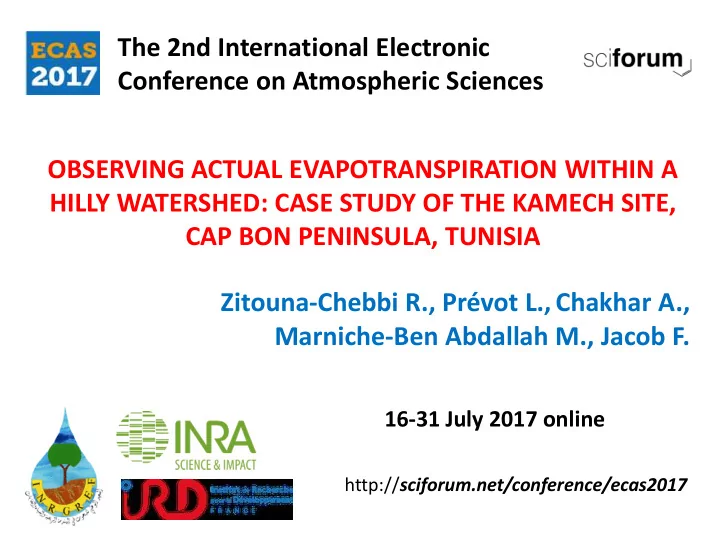

The 2nd International Electronic Conference on Atmospheric Sciences OBSERVING ACTUAL EVAPOTRANSPIRATION WITHIN A HILLY WATERSHED: CASE STUDY OF THE KAMECH SITE, CAP BON PENINSULA, TUNISIA Zitouna-Chebbi R., Prévot L., Chakhar A., Marniche-Ben Abdallah M., Jacob F. 16-31 July 2017 online http:// sciforum.net/conference/ecas2017
Plan 1. General context 4. Results – Actual evaoptranspiration* – Climatic conditions – Long term series – Gap filling – Seasonal variations of daily 2. Objective surface fluxes Monthly 3. Experiments and evapotranspiration methodology 5. Conclusion – Study site – Methodological conclusion – Instruments – General conclusion – Flux calculations 6. Acknowledgments – Gap filling methods
1.1 Actual evapotranspiration ETa Water scarcity increases Need to observe water cycle components in order to diagnostic processes and pronostic future trends Hydrological observatories Flux tower observatories increases increases but ETa is rarely but few are in agricultural system observed and under hilly topography Agricultural hilly watersheds are widespread on Earth and allow intensification of agriculture
1.2 Long term series ETa under hilly topography EC Missing data Eddy covariance (EC) techniques sensor or power failures, permit continuous maintenance and calibration monitoring of land procedures, improper weather surface fluxes, conditions, and rejection of data including ETa induced by quality checks. For hilly conditions For long term series Necessary to adapt correction Several gap filling techniques are methods for EC measurements, or proposed in littérature but existing to account for footprint changes gap-filling methods have not been according to wind direction. examined over hilly cropping systems
2. Objective Obtaining continuous ETa time series from Eddy Covariance measurements collected within a small hilly watershed, which implied adapting gap-filling techniques to these particular conditions.
3. Experiments and methodology 3.1 Study site : Kamech agricultural watershed 3.2 Instruments : Flux tower 3.3 Flux calculations 3.4 Gap filling methods
3.1 Kamech agricultural watershed http://www.obs-omere.org area of 2.45 km 2 Hilly totography Rainfed Crops Cereals : Wheat/Oat/Barley Legumes: Favabeans/ Chickpeas Rangeland: natural vegetation Climat Annually averaged over the 2004-2014 period two dominant wind directions, that might Precipitation 680 mm interact with the hilly Penman-Monteith reference topography. evapotranspiration 1366 mm
3.2 Eddy covariance flux tower Flux tower 9.6 m Meteorological station Open path gas CO 2 / H 2 O analyzer Data collected from: (LI-7500, LiCor Biosciences, USA) 04/2010 to 08/2013 3D anemometer (CSAT3, Campbell Scientific, USA
3.3 Flux calculations Raw EC data: vertical wind speed, 20 Hz air temperature and humidity ECpack Flux calculation ECpack library version 2.5.22 and corrections + 30 mn Steady State test Contrôl quality Integral Turbulence characteristics test Hourly convective fluxes 30 mn sensible heat (H) and latent ( E) With missing data 53% for H and 78% for E
3.4 Gap filling Reichstein et al. (2005) Model of Gap-filling REddyProc package 1 2 Separation of Original version wind direction (with all data) H RNS and E RNS H REP and E REP . Hourly data ( E and H ) reconstructed E=ETa and H 24 h and monthly
4. Results 4.1 Climatic conditions 4.2 Gap filling 4.3 Seasonal variations of daily surface fluxes 4.4 Monthly evapotranspiration
4.1 Climatic conditions ET0 is almost similar between the Rainfall shows differences during four years of the experiment humid period but it is almost nul during summer As a typical Mediterranean site, two contrating periods were clearly distinguished: - a little evaporative demand (ET0) and available water (humid period) (from October to April) - a high evaporative demand and dry period (from May to September).
4.2 Impact of taking into account the wind direction in REddyProc Sensible heat (H) Latent heat( E) REddyProc discrimination North and South winds Hourly Differences observed when sdiscriminating wind direction for H and E Daily No differences observed Monthly No differences observed when discriminating wind direction for H and E REddyProc original
4.3 Seasonal variations of daily surface fluxes REddyProc was able to gap-fill missing flux data most of the time, except when the duration of the periods with missing data were to long. The time series of H and E emphasized the high consistency of the land surface fluxes obtained over this hilly watershed.
4.4 Monthly evapotranspiration Maximum of Eta is reached on April, it is the maximum of vegetation growth for the rainfed crops of the watershed In August, for bare conditions, Eta is 1 mm for the four years ETa deduced from EC measurements exhibited a very good consistency for the four years Clear and coherent seasonal variations of the ratio ETa/ET 0
5. Conclusion 5.1 Methodological conclusion 5.2 General conclusion
5.1 Methological conclusion The REddyProc method was chosen to gap-fill the missing flux data, but was adapted to our particular conditions by separating the flux dataset between the two dominant wind directions. It was demonstrated that at hourly timescale, it was necessary to discriminate between wind directions. Conversely, the fluxes obtained with or without discriminating wind directions were very similar at daily and monthly timescales.
5.2 General conclusion Our results gave great confidence in the observation of land surface fluxes by EC measurements over a small hilly watershed. These flux time series could be further used for validating hydrological models, or for testing water management scenarios to mitigate the effect of global change.
Acknowledgments The author’s express their thanks to : the Environmental Research Observatory OMERE (http://www.obs-omere.org) and the data used are available https://zenodo.org/record/821527#.WVZcssbpORs) according to its data policy; the MISTRALS/SICMED program; French National Research Agency (ANR) TRANSMED program through the ALMIRA project (contract ANR-12-TMED-0003) for their financial support provided for this study; The technical staff from INRGREF and UMR LISAH particularly Rim Louati and François Garnier.
Thank you
Recommend
More recommend